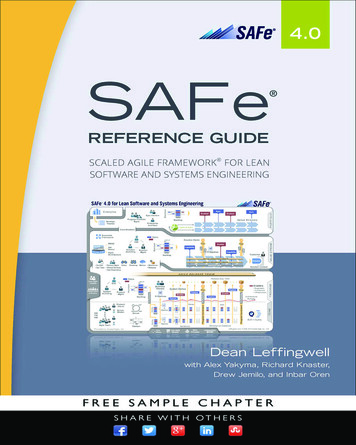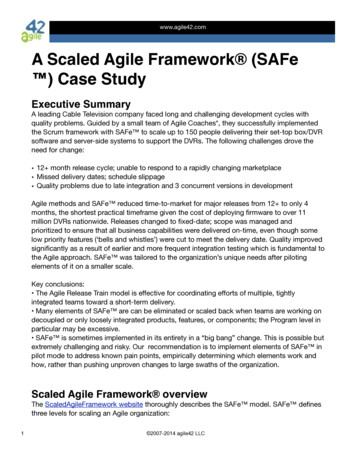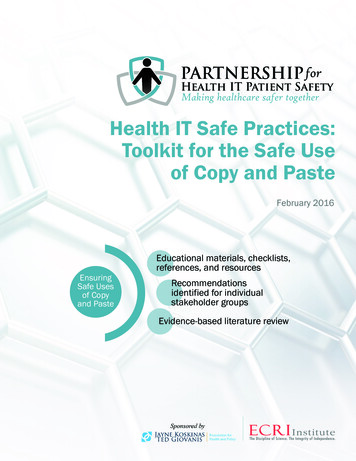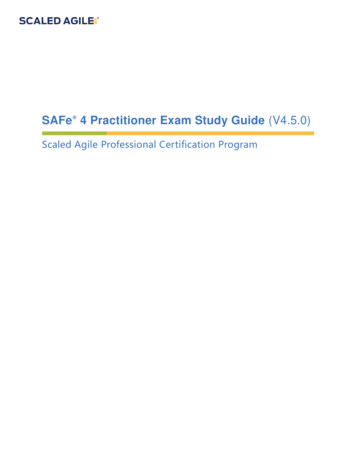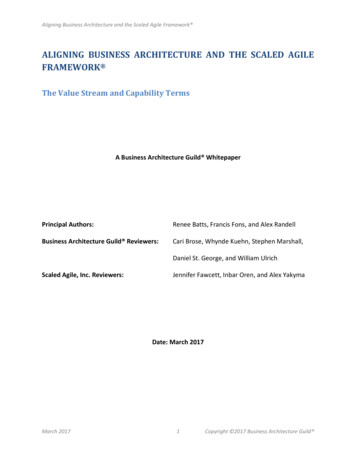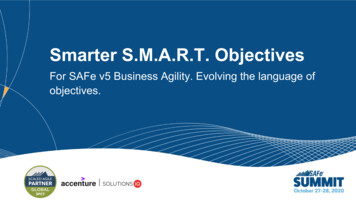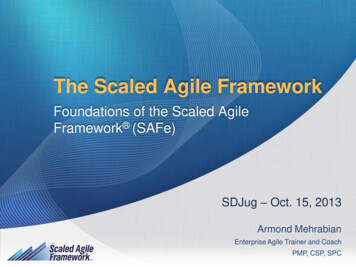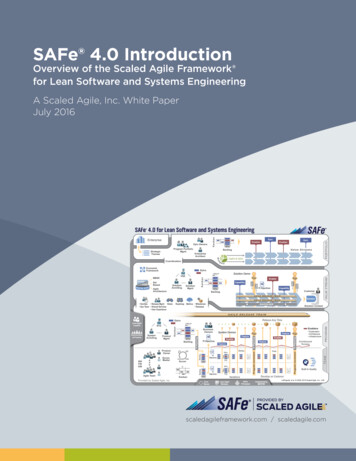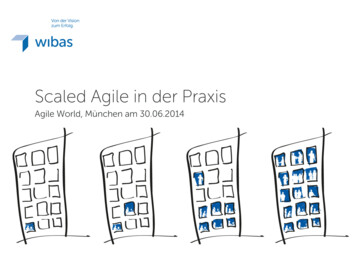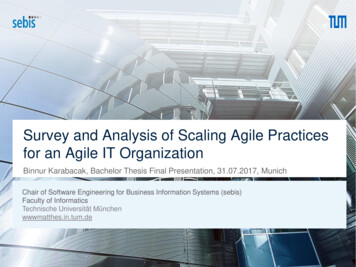
Transcription
SAFe 5.0 Glossary Scaled Agile Framework Terms and DefinitionsEnglishPROVIDED BYwww.scaledagileframework.com www.scaledagile.com Scaled Agile, inc.
Hidden Topic Title Text
Guide to acronyms and abbreviationsARTAgile Release TrainPDCAPlan, Do, Check, AdjustBOBusiness OwnerPIProgram IncrementBVBusiness ValuePMProduct ManagementBVIRBig Visual Information RadiatorPO/PM Product Owner/Product ManagerCapEx Capital ExpensesPOProduct OwnerCDContinuous DeliveryROAM Resolved, Owned,CEContinuous ExplorationCIContinuous IntegrationCFDCumulative Flow DiagramCoDCost of DelayCoPCommunity of PracticeDoDDefinition of DoneDSUDaily Stand-upEAEnterprise ArchitectEOEpic OwnerSMART Specific, Measurable, Achievable,Realistic, Time-boundFWFirmwareSoSScrum of ScrumsHWHardwareSPSAFe PractitionerI&AInspect and AdaptSPCSAFe Program ConsultantIPInnovation and Planning (iteration)STESolution Train EngineerKPIKey Performance IndicatorSWSoftwareLPMLean Portfolio ManagementUXUser ExperienceMBSEModel-Based Systems EngineeringVSValue StreamMMFMinimum Marketable FeatureVSEValue Stream EngineerMVPMinimum Viable ProductWIPWork in ProcessNFRNonfunctional RequirementsWSJFWeighted Shortest Job FirstOEOpportunity EnablementXPExtreme ProgrammingOpExOperating ExpensesAccepted, MitigatedRRRisk ReductionRTERelease Train EngineerS4TSAFe for TeamsSAFe Scaled Agile FrameworkSASAFe AgilistSBDSet-Based DesignSMScrum Master Scaled Agile, Inc. www.scaledagileframework.com 3
SAFe 5.0 GlossaryAgile Release Train (ART)The Agile Release Train (ART) is a long-lived team of Agile teams, which, along withother stakeholders, incrementally develops, delivers, and where applicable operates,one or more solutions in a value stream.Agile TeamIn SAFe, an Agile team is a cross-functional group of 5-11 individuals who define, build,test, and deliver an increment of value in a short time box.Architectural RunwayThe Architectural Runway consists of the existing code, components, and technicalinfrastructure needed to implement near-term features without excessive redesign anddelay.Built-In QualityBuilt-In Quality practices ensure that each Solution element, at every increment, meetsappropriate quality standards throughout development.Business OwnersBusiness Owners are a small group of stakeholders who have the primary business andtechnical responsibility for governance, compliance, and return on investment (ROI) fora Solution developed by an Agile Release Train (ART). They are key stakeholders onthe ART who must evaluate fitness for use and actively participate in certain ARTevents.CapabilitiesA Capability is a higher-level solution behavior that typically spans multiple ARTs.Capabilities are sized and split into multiple features to facilitate their implementation ina single PI.Communities of Practice (CoPs)Communities of Practice (CoPs) are organized groups of people who have a commoninterest in a specific technical or business domain. They collaborate regularly to shareinformation, improve their skills, and actively work on advancing the general knowledgeof the domain.ComplianceCompliance refers to a strategy and a set of activities and artifacts that allow teams toapply Lean-Agile development methods to build systems that have the highest possiblequality, while simultaneously assuring they meet any regulatory, industry, or otherrelevant Scaled Agile, Inc. www.scaledagileframework.com 4
Continuous Delivery PipelineThe Continuous Delivery Pipeline (CDP) represents the workflows, activities, andautomation needed to shepherd a new piece of functionality from ideation to an ondemand release of value to the end user.Continuous Deployment (CD)Continuous Deployment (CD) is the process that takes validated Features in a stagingenvironment and deploys them into the production environment, where they are readiedfor release.Continuous Exploration (CE)Continuous Exploration (CE) is the process that drives innovation and fosters alignmenton what should be built by continually exploring market and customer needs, anddefining a Vision, Roadmap, and set of Features for a Solution that addresses thoseneeds.Continuous Integration (CI)Continuous Integration (CI) is the process of taking features from the Program Backlogand developing, testing, integrating, and validating them in a staging environment wherethey are ready for deployment and release.Core ValuesThe four Core Values of alignment, built-in quality, transparency, and programexecution represent the fundamental beliefs that are key to SAFe’s effectiveness. Theseguiding principles help dictate behavior and action for everyone who participates in aSAFe portfolio.DevOpsDevOps is a mindset, a culture, and a set of technical practices. It providescommunication, integration, automation, and close cooperation among all the peopleneeded to plan, develop, test, deploy, release, and maintain a Solution.EnablersAn Enabler supports the activities needed to extend the Architectural Runway to providefuture business functionality. These include exploration, architecture, infrastructure, andcompliance. Enablers are captured in the various backlogs and occur throughout theFramework.EnterpriseThe Enterprise represents the business entity to which each SAFe portfolio belongs.Enterprise Solution DeliveryThe Enterprise Solution Delivery competency describes how to apply Lean-Agileprinciples and practices to the specification, development, deployment, operation, andevolution of the world’s largest and most sophisticated software applications, networks,and cyber-physical systems. Scaled Agile, Inc. www.scaledagileframework.com 5
Epic OwnersEpic Owners are responsible for coordinating portfolio Epics through the PortfolioKanban system. They collaboratively define the epic, its Minimum Viable Product(MVP), and Lean business case, and when approved, facilitate implementation.EpicsAn Epic is a container for a significant Solution development initiative that captures themore substantial investments that occur within a portfolio. Due to their considerablescope and impact, epics require the definition of a Minimum Viable Product (MVP) andapproval by Lean Portfolio Management (LPM) before implementation.Essential SAFeEssential SAFe contains the minimal set of roles, events, and artifacts required tocontinuously deliver business solutions via an Agile Release Train (ART) as a Team ofAgile Teams.FeaturesA Feature is a service that fulfills a stakeholder need. Each feature includes a benefithypothesis and acceptance criteria, and is sized or split as necessary to be delivered bya single Agile Release Train (ART) in a Program Increment (PI).FoundationThe Foundation contains the supporting principles, values, mindset, implementationguidance, and leadership roles needed to deliver value successfully at scale.Full SAFeFull SAFe is the most comprehensive configuration, including all seven corecompetencies needed for business agility.Innovation and Planning IterationThe Innovation and Planning (IP) Iteration occurs every Program Increment (PI) andserves multiple purposes. It acts as an estimating buffer for meeting PI Objectives andprovides dedicated time for innovation, continuing education, PI Planning, and Inspectand Adapt (I&A) events.Inspect & Adapt (I&A)The Inspect and Adapt (I&A) is a significant event, held at the end of each ProgramIncrement (PI), where the current state of the Solution is demonstrated and evaluatedby the train. Teams then reflect and identify improvement backlog items via astructured, problem-solving workshop.IterationIterations are the basic building block of Agile development. Each iteration is astandard, fixed-length timebox, where Agile Teams deliver incremental value in the formof working, tested software and systems. The recommended duration of the timebox is Scaled Agile, Inc. www.scaledagileframework.com 6
two weeks. However, one to four weeks is acceptable, depending on the businesscontext.Iteration ExecutionIteration Execution is how Agile Teams manage their work throughout the Iterationtimebox, resulting in a high-quality, working, tested system increment.Iteration GoalsIteration Goals are a high-level summary of the business and technical goals that theAgile Team agrees to accomplish in an Iteration. They are vital to coordinating an AgileRelease Train (ART) as a self-organizing, self-managing team of teams.Iteration PlanningIteration Planning is an event where all team members determine how much of theTeam Backlog they can commit to delivering during an upcoming Iteration. The teamsummarizes the work as a set of committed Iteration Goals.Iteration RetrospectiveThe Iteration Retrospective is a regular meeting where Agile Team members discussthe results of the Iteration, review their practices, and identify ways to improve.Iteration ReviewThe Iteration Review is a cadence-based event, where each team inspects theincrement at the end of every Iteration to assess progress, and then adjusts its backlogfor the next iteration.Large Solution SAFeLarge Solution SAFe describes additional roles, practices, and guidance to build andevolve the world's largest applications, networks, and cyber-physical systems.Lean Budget GuardrailsLean Budget Guardrails describe the policies and practices for budgeting, spending,and governance for a specific portfolio.Lean BudgetsLean Budgets provide effective financial governance over investments, with far lessoverhead and friction, and supports a much higher throughput of development work.Lean EnterpriseThe Lean Enterprise is a thriving digital age organization that exhibits business agility —responding quickly to market changes and emerging opportunities by deliveringinnovative systems and solutions to its customers in the shortest sustainable lead-time. Scaled Agile, Inc. www.scaledagileframework.com 7
Lean Portfolio ManagementThe Lean Portfolio Management competency aligns strategy and execution by applyingLean and systems thinking approaches to strategy and investment funding, Agileportfolio operations, and governance.Lean User Experience (Lean UX)Lean User Experience (Lean UX) design is a mindset, culture, and a process thatembraces Lean-Agile methods. It implements functionality in minimum viableincrements and determines success by measuring results against a benefit hypothesis.Lean-Agile LeadershipThe Lean-Agile Leadership competency describes how Lean-Agile Leaders drive andsustain organizational change and operational excellence by empowering individualsand teams to reach their highest potential.Lean-Agile MindsetThe Lean-Agile Mindset is the combination of beliefs, assumptions, attitudes, andactions of SAFe leaders and practitioners who embrace the concepts of the AgileManifesto and Lean thinking. It’s the personal, intellectual, and leadership foundation foradopting and applying SAFe principles and practices.Lean-Agile PrinciplesSAFe is based on ten immutable, underlying Lean-Agile principles. These tenets andeconomic concepts inspire and inform the roles and practices of SAFe.MetricsMetrics are agreed-upon measures used to evaluate how well the organization isprogressing toward the portfolio, large solution, program, and team’s business andtechnical objectives.MilestonesMilestones are used to track progress toward a specific goal or event. There are threetypes of SAFe milestones: Program Increment (PI), fixed-date, and learning milestones.Model-Based Systems Engineering (MBSE)Model-Based Systems Engineering (MBSE) is the practice of developing a set of relatedsystem models that help define, design, and document a system under development.These models provide an efficient way to explore, update, and communicate systemaspects to stakeholders, while significantly reducing or eliminating dependence ontraditional documents.Nonfunctional Requirements (NFRs)Nonfunctional Requirements (NFRs) define system attributes such as security,reliability, performance, maintainability, scalability, and usability. They serve asconstraints or restrictions on the design of the system across the different backlogs. Scaled Agile, Inc. www.scaledagileframework.com 8
PI ObjectivesProgram Increment (PI) Objectives are a summary of the business and technical goalsthat an Agile Team or train intends to achieve in the upcoming Program Increment (PI).Portfolio BacklogThe Portfolio Backlog is the highest-level backlog in SAFe. It provides a holding area forupcoming business and enabler Epics intended to create and evolve a comprehensiveset of Solutions.Portfolio KanbanThe Portfolio Kanban system is a method to visualize and manage the flow of portfolioEpics, from ideation through analysis, implementation, and completion.Portfolio SAFePortfolio SAFe aligns strategy with execution and organizes solution developmentaround the flow of value through one or more value streams.Portfolio VisionThe Portfolio Vision is a description of the future state of a portfolio’s Value Streams andSolutions and describes how they will cooperate to achieve the portfolio's objectives andthe broader aim of the Enterprise.Pre-and Post-PI PlanningPre– and Post–Program Increment (PI) Planning events are used to prepare for, andfollow up after, PI Planning for Agile Release Trains (ARTs) and Suppliers in a SolutionTrain.Product ManagementProduct Management is responsible for defining and supporting the building ofdesirable, feasible, viable, and sustainable products that meet customer needs over theproduct-market lifecycle.Product Owner (PO)The Product Owner (PO) is a member of the Agile Team responsible for defining Storiesand prioritizing the Team Backlog to streamline the execution of program priorities whilemaintaining the conceptual and technical integrity of the Features or components for theteam.Program BacklogThe Program Backlog is the holding area for upcoming Features, which are intended toaddress user needs and deliver business benefits for a single Agile Release Train(ART). It also contains the enabler feature
SAFe 5.0 Glossary Agile Release Train (ART) The Agile Release Train (ART) is a long-lived team of Agile teams, which, along with other stakeholders, incrementally develops, delivers, and where applicable operates, one or more solutions in a value stream. Agile Team In SAFe, an Agile team is a cross-functional group of 5-11 individuals who define, build, test, and deliver an increment of value .

